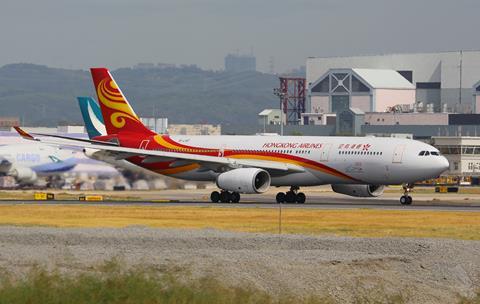Hong Kong investigators have concluded that an air traffic controller’s temporary loss of situational awareness resulted in a Hong Kong Airlines A330-300 being cleared to take off from a runway that a Cathay Pacific Airways Boeing 747-8F was crossing.
As the A330 (B-LNU) was cleared to take-off from Runway 07R, its crew quickly aborted the take-off when they spotted the 747-8 (B-LJH) crossing at the other end. The 747 crew, for their part, had immediately called the controller to say they had not cleared the runway when they learned that the A330 had been given take-off clearance.

During the incident, which occurred at 21:07 on 23 December 2017, neither aircraft came within 3,000m (9,800 feet) of each other. B-LNU, which stopped within 200 metres, subsequently took off safely and operated a service to Bali.
The incident is detailed in a final report from Hong Kong’s Air Accident Investigation Authority, which rates it as serious.
The report states that the flight crew on both aircraft handled the situation properly. It attributes the incident to the controller’s “momentary lapse of situational caused by distraction.”
The report details distractions immediately before the incident involving aircraft ahead of B-LNU in the queue to depart from Runway 07R.
One aircraft had a radio problem and had to vacate the runway via a taxiway – the crew also set the transponder to “7600”, an emergency code for radio communication failure that generated a three-minute aural alarm in the control tower. The next aircraft in-line - and two aircraft before B-LNU – reported a medical issue, and the controller directed it to a holding position.
After the aircraft ahead of the A330 B-LNU took off, the controller directed B-LNU to line up on Runway O7R, and also directed the 747 B-LJH, which had earlier arrived from Anchorage on runway 07L, to hold at the J11 holding point at the far end of the runway.
Meanwhile, the controller coordinated with a ground movement controller regarding the aircraft that had reported a medical issue. He then cleared B-LJH to cross the Runway 07R, and 31s later cleared B-LNU to take-off.
Contributing to the controller’s lack of awareness was an inadequate scan of the runway prior to giving B-LNU clearance to take off, and not following standard operating procedure, which called for an electronic “Runway Blocked” strip to be used while B-LJH crossed the runway.
Investigators note that the incident took place just three months after a similar incident on the same runway, where the crew of a 747-400SF misconstrued a taxi instruction to include a runway crossing clearance. This resulted in an Airbus A330-300’s having to abort its take-off roll when the 747 entered the active runway.
Following the December 2017 incident, procedures were changed to give aircraft lining up for take-off better situational awareness about other aircraft crossing the runway. In addition, an instruction was issued that “consolidated and updated operational procedure changes related to runway crossing operations in the eight months prior to this occurrence.”
The report makes recommendations to the Air Navigation Services Provider about controller training, enforcing the “Runway Blocked” procedure, and reviewing the status/function of operational audible alarms.
B-LNU was carrying 255 passengers and 12 crew, and the freighter B-LJH three crew. No injuries were reported.



















